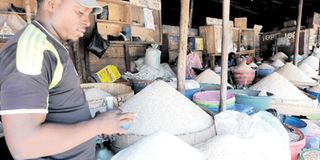Rice prices down as supply rises during harvest season

Rice vendor, Fredy Gabiel waits for customers at Kisutu market in Dar es Salaam yesterday. PHOTO|SAHLIM SHAO
What you need to know:
- A survey by The Citizen in various city markets has established that the wholesale price of a 100-kilo bag of rice dropped from between Sh160,000 and Sh220,000 early April this year to between Sh120,000 and Sh180,000 last week, depending on quality.
Dar es Salaam. Rice prices have fallen as supply has increased.
A survey by The Citizen in various city markets has established that the wholesale price of a 100-kilo bag of rice dropped from between Sh160,000 and Sh220,000 early April this year to between Sh120,000 and Sh180,000 last week, depending on quality.
Retail prices also eased from an average of Sh2,400 a kilo to between Sh1,600 and Sh2,000 during the period under review. Many regions that grow rice are harvesting the crop and that is why supply has risen.Temeke Grains Agency director Peter Kato says the volume of rice he receives has improved.
“I receive up to 300 bags a day from, up from 150 bags in the past months, thanks to improvement in harvest in many regions,” said Mr Kato, who manages more than 41 stores (wholesale and retail) in Temeke Double Cabin.
Tandika market chairman Mohamed Mwekya expects the prices to further drop in the coming months as some regions are still harvesting crop and therefore supply will increase.
According to the Ministry of Agriculture, rice is the second most produced cereal crop in Tanzania, with over 1.68 million growers, 1.59 million of them being on the Mainland Tanzania and 79,736 in Zanzibar.
Tabora has the largest planted area in Mainland Tanzania, with paddy grown on 248,703 hectares followed by Morogoro with 221,864 hectares. Shinyanga and Arusha follow.Pemba South leads in Zanzibar with 8,196 hectares planted area with paddy followed by Pemba North with 5,983 hectares and Urban West with 971 hectares.
Morogoro produced 24.5 per cent of the rice in Tanzania in 2016/17 followed by Mbeya which accounted for 18.2 per cent of the total output. White rice is about 90 per cent carbohydrate, 8 per cent protein and 2 per cent fat, according to a book titled ‘Contemporary Nutrition: Functional Approach’.
White rice is a good source of magnesium, phosphorus, manganese, selenium, iron, folic acid, thiamine and niacin.




